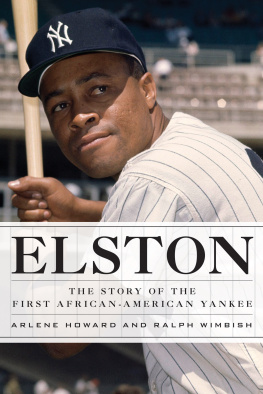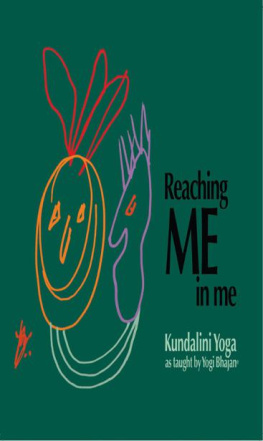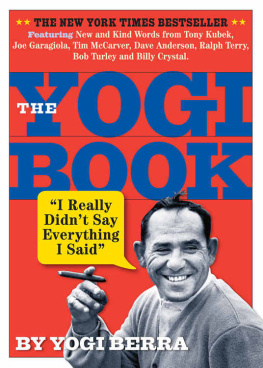
This book is dedicated to Dawson Cordell DeVito, the All-Star catcher in our family, and to Dylan Charles DeVito, the All-Star pitcher in our family, and to Eugene T. Venanzi II, my brother and a huge sports aficionado.
Contents
Preface
Yogi Berra is one of the most famous players in the history of Major League Baseball. He has written several different versions of his own life, and there have been numerous unauthorized versions of his life. He has appeared in several hundred books as a character in someone elses story. And he is quoted as often as Sir Winston Churchill, the great British statesman, and Mark Twain.
Over the years he has often been misquoted, and stories apocryphally have been ascribed to him that never really occurred. He even wrote a book about it himself titled The Yogi Book: I Really Didnt Say Everything I Said, in an effort to set the record straight.
Regardless of his efforts, there are many instances where quotes attributed to him are told in different settings, with different people, or with different words. Some are the work of overzealous sportswriters and historians, and Berra himself has told the same stories differently over the years.
Sifting through more than 4,000 newspaper articles, magazines, interviews, books, and programs, I have tried my best to get to the real story. In certain instances, I have called out the most egregious errors. In other instances, I told the story based on the best research available.
I have done so to the best of my abilities.
Acknowledgments
The author must acknowledge and commend Ken Samelson, who offered up my name to Triumph some time ago. I thank him for his advice on this book, his researching assistance, and his diligent fact-checking. Without Ken, this book would not have happened, and I am grateful for his friendship and advice.
Any author of such an effort owes a great debt of gratitude to those who went before him. Several writers works have proved invaluable, including Peter Golenbocks, Roger Kahns, and Maury Allens many works; David Halberstams Summer of 49 and October 1964; Jim Boutons Ball Four; Robert Creamers Stengel; Leigh Montvilles Ted Williams; Richard Ben Cramers Joe DiMaggio; Joseph R. Carrieris two books, most recently Searching for Heroes; and of course the memoirs of Mickey Mantle, Whitey Ford, Don Larsen, Phil Rizzuto, Billy Martin, and many other teammates of Yogis from throughout the years.
Also to be thanked are the numerous biographers who have gone before me, including Dave Kaplan, Edward Fitzgerald, Tom Horton, Phil Pepe, Bob Klapisch, and Gene Schoor, as well as playwright Tom Lysaghts Nobody Dont Like Yogi.
Of course, I poured over more than 4,000 original sources, including some 1,000 interviews with players, umpires, managers, and other assorted folks. I also examined newspaper and magazine articles from Berras youth all the way to the present. It is hard to imagine writing this work without the dedicated and hard-working beat writers who covered the team over the years, including Arthur Daley, Joe Trimble, Red Smith, Phil Pepe, Dick Young, John Drebinger, Leonard Koppett, Dave Anderson, Robert Lipsyte, Mike Lupica, and many others. Without their dedicated coverage and investigative reporting, the book could not have been written. My apologies to anyone whose name was inadvertently left off this listyou can probably be found in the notes at the end of this book.
As ever, I owe a debt of special thanks in all of my professional endeavors to Gilbert King for his ear, opinions, advice, general good cheer, and encouragement.
I would, of course, like to thank Tom Bast and Mitch Rogatz of Triumph Books, who helped make this book a reality. Were it not for their excitement and enthusiasm, I might have given up under the weight of this massive project. I also owe a huge debt of gratitude to editors Kelley White and Adam Motin who helped mold a rather large manuscript into readable shape.
I would also like to thank my agent and friend Edward Claflin of Edward B. Claflin Literary Agency. I thank him for his encouragement and assistance, and for his belief in me.
I would like to thank my sons, Dylan and Dawson, whom I have taken too much time away from in order to pursue not only this work, but also my other professional aspirations. I have attended almost every game of their Little League careers, but there is no replacement for a catch or an ice-cream cone, many of which were robbed by my other pursuits. I vow to them to spend more time playing and less time working.
And lastly I would like to thank my wife, Dominique, who has suffered this project and my other pursuits with a smile in the worst of moments. She is an incredible life partnerfriend, confidant, counselor, confessor, secretary, and manager of our homes and lives. My successes in business, as well as in parenthood, are a direct result of her effort, love, understanding, and immense patience. She makes my failures and disappointments seem inconsequential. I thank her, as usual, most of all.
Introduction
Recently, in New York City, two new baseball stadiums were erected and completed. One is situated in the Bronx, the other in Queens. Both are near the location of their predecessors. If you are lucky enough to live in the New York metropolitan area, there is a fitting tribute to Yogi Berra in each. They are as subtle as they are unmistakable. If you go to the new Yankee Stadium, there is a giant version of the famous picture of Berra hugging Don Larsen after the fireballer completed a perfect game in the World Series. It is one of the most iconic photos in baseball history. Now of course, if you are a baseball fan, you will also make your way over to Citi Field, the new home of the New York Mets. There, in a photo just as huge and just as famous, is the photo of Jackie Robinson stealing home on none other than the same Yogi Berra.
That Yogi Berra is featured at both ballparks may seem odd to fans today, but both franchises lay claim to the small, muscled ex-catcher. Berra played his entire career with the New York Yankees, save a few at-bats with the New York Mets. He went to 14 World Series with the Yankees during the course of his life, but he also led the Mets to their 1973 World Series appearance. In fact, he spent seven years within the Mets franchise and was one of its most popular personalities. He has been a featured old-timer in both ballparks.
Ive done it before, Berra told the press, on the day of the opening of the Stadium. He had thrown out the first pitch in a Yankees home opener seven times. I hope I can get it there. Lets see what happens.
Berra bounced his pitch to Jose Molina on April 19, 2009. The crowd cheered anyway.
I think theyve got too much room in the clubhouse, Berra said. Its an awfully big locker room. To me, if you want to talk to a guy, youve got to walk a half a mile.
Yogi Berra has been a fixture, a fact of life, in New York baseball since 1947. For more than 66 of his 88 years, he has been a much loved, iconic figure in a city that can be notoriously impatient as it can be harsh. They booed Joe DiMaggiothey could boo anyone. But Yogi Berranot so much.
That is Yogi Berra. Not bad for a kid from St. Louis.
Of course, before he got to New York, he had to go to France. At the age of 18, Berra enlisted in the United States Navy, and D-day found the young baseball hopeful launching rockets at the Germans on the beaches of Normandy.
I think his military service has been a little overlooked, because the men like him really didnt talk about it much, said Carmen Berra, Yogis wife of 64 years. He never talked about it. It wasnt a big thing to him, or to men like him. It was just what they had to do.
Next page








